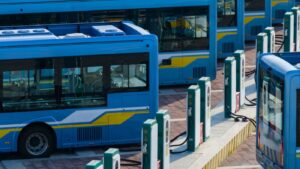Low-emission Transportation and the Path to Scale – Takeaways from Cleantech Forum San Francisco
At this year’s Cleantech Forum San Francisco, we were on the road in Palm Springs as well as on screen for those who could not join us in person. Over two weeks, I hosted four transportation sessions, covering heavy-duty transportation, EV charging, maritime shipping and hydrogen.
A recurring theme was how crucial the next five to ten years will be to keep warming below two degrees Celsius and avoid the disastrous impacts of the climate crisis. Decarbonization is no longer reserved for the vanguards of sustainability. Climate change is the biggest threat to every industry and is underpinning every strategic discussion. Corporate and government commitments to reach net zero emissions are driving the market, and now low-emission technologies need to scale up.
With net zero emissions and keeping global warming below 1.5 degrees Celsius as guiding principles, key areas to keep an eye on over the next few years will be scale up of infrastructure to support low-emission transportation, increasing attention on hard-to-abate sectors, including aviation, maritime and heavy-duty trucks and equipment and innovation and investment in vehicle components and fuels.
Subsidies and grants are critical for supporting first movers and enabling progress
Demand for low-emission vehicles is rapidly increasing, both for private and commercial vehicles. However, the higher purchase cost is a barrier to early adoption. Government subsidies and grants are needed to help early adopters get over the hump, achieve economies of scale and bring costs down to enable mass market adoption. Although EVs provide a lower total cost of ownership over a vehicle’s life due to lower fuel and maintenance costs, higher purchase costs inhibit adoption for capital-constrained buyers, such as low-income vehicle owners and industries with already tight margins, such as heavy-duty trucking.

There is no silver bullet, a suite of solutions is needed
For maritime shipping, heavy duty off-road and on-road trucking and even aviation, decarbonization will be more difficult than lighter duty sectors, such as passenger cars and micromobility. Requirements such as long range, large payloads and weight make battery electric propulsion difficult for many heavy-duty sectors. In order to reduce emissions, a suite of solutions will be needed, including low-emission fuels such as hydrogen, green ammonia and green ethanol.
However, challenges remain to make low-emission fuels commercially and technologically competitive for heavy-duty transport. More innovation is needed to ensure fuels are low emission and can scale to meet demand. Innovation is also needed in EV battery technology to improve viability for heavy-duty sectors. One company we heard from, ClearFlame Engines, is developing engine technology that allows diesel engines to run on any low-emission fuel. Innovations like this can help make a near-term impact on emissions and catalyze demand and innovation in low-emission fuels.

Ecosystems and partnerships will be key to building out infrastructure
Market demand signals are needed to trigger investment into fueling and charging infrastructure. One good example of this that we heard from Lee Kindberg at Maersk is the green shipping corridor between Los Angeles and Shanghai they are working on with partners. Another example mentioned by Joe Pratt from Zero Emission Industries was aggregating demand for hydrogen at ports to bring down fuel costs and create an investment case for fueling infrastructure. Even a small fleet of hydrogen-fueled tug boats could create significant demand for hydrogen, bringing down the cost of fuel for other users as well, such as cargo handling equipment and heavy-duty trucks.
For EV charging, several stakeholders, including automakers, electric utilities, EV charging network operators, real estate developers, energy management software innovators and even landlords will need to get involved and work together to intelligently plan for and build out charging infrastructure. One of the biggest bottlenecks for electrification currently, particularly for high-power fast charging, is the lengthy permitting and grid interconnection process. Increased collaboration and planning between stakeholders could help shorten that time and deploy charging infrastructure more quickly. In addition, there is a wide range of applications and use cases for EV charging, and a broad range of solutions is needed both for hardware and software to manage stations, maximize uptime, manage payment and billing and minimize costs for all stakeholders.



